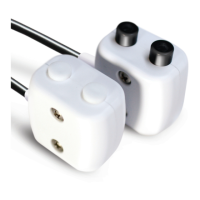SRS Sensors 2 ABOUT SRS
2 About SRS
2.1 Overview
The SRS are two-band radiometers that measure either incident or
reflected radiation in wavelengths appropriate for calculating the
Normalized Difference Vegetation Index (NDVI) or the Photochemi-
cal Reflectance Index (PRI). Sensors are manufactured in four differ-
ent versions: NDVI-hemispherical, NDVI-field stop, PRI-hemispherical
and PRI-field stop. The hemispherical versions (Figure 1) are built
with Teflon diffusers for making cosine-corrected measurements, and
are primarily designed for up looking measurements of incident radi-
ation. The field stop versions (Figure 2) have a field of view restricted
to 20
◦
and are designed for pointing downward to measure canopy
reflected radiation in NDVI and PRI wavelengths.
The reflected radiation from a vegetated surface is highly variable,
depending on the amount and type of vegetation cover. This vari-
ability requires a relatively large number of sensors to properly char-
acterize this surface. The field stop and hemispherical versions can
both be used to quantify canopy reflected radiation. The correct
choice of sensor will depend on the objectives of the study. The
hemispherical sensor will do a better job of averaging reflected radia-
tion over a broad area, but if it is not installed normal to the canopy
surface it will also average sky, leading to measurement error. The
field stop sensor can be aimed at a particular spot or have a particu-
lar orientation giving the user more control over what portion of the
canopy is being measured. When using the field stop sensor in an
off-nadir orientation the user should be careful that the sensor is not
pointed above the horizon.
Calculating NDVI or PRI requires knowing both the incoming and
reflected radiation. Unlike the reflected radiation, the incoming radi-
ation is spatially uniform above the canopy. So, you only need one up
facing radiometer to compute the vegetation indices for many down
facing radiometers. The up looking radiometer should be leveled and
have a hemispherical field of view.
3

